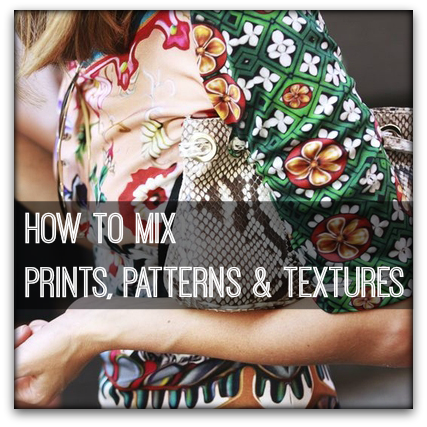
Do you get a little bamboozled when it comes to mixing prints and patterns together? It’s not really that difficult when you have a few tried and true guidelines to follow.
The more prints and patterns you try to combine in one outfit the more skill it takes, and when the fad/trend is at its height you’ll see designers pushing the boundaries to imprint their ideas on the fashion forward. The wiser of us will pull back a little from their flights of fantasy and create outfits that work for our height, weight, shape and age.
Know When to say No
When you peruse stores and fashion magazines you’ll be bombarded with photos of models wearing all manner of weirdness, and just because a model is wearing it or a designer has deemed it to be ‘in’ does not mean that it’s worthy of wearing.
When you see a look you’re attracted to ask yourself:
- Will I be the focus if I wear this? If the outfit is the clear attention winner – pass it by.
- Do I feel a sense of confusion looking at this? Yes – pass it by.
- Is it ugly? Yes – pass it buy.
- If I wear this will my best or worst features be highlighted? No need to give you the answer here.
- Will I get my money worth in wearings from these pieces, or, it it a one season only look? One season – pass it by unless you have plenty of cash to spend.
- Can they be separated to create other outfits? No- pass it by.

Get insync
Here are how to to mix prints and patterns together:
- If you are a novice max out at two patterns.
- The busier or more complex the pattern/print, the better you are to coordinate it with a solid colored garment or a garment with a simple pattern or texture.g, pin stripe

- When mixing prints and patterns look for a characteristic that you can use to unite the patterns. This may be a colour (the easiest), the theme or design line.

- Texture should be considered a pattern if the pattern is obvious when you stand 1 meter (3 feet) away from the garment.

- Different textures are often easier to mix than different patterns.

- One pattern should be dominant so the eye has a place to settle on first. And that place should be your best area given that’s where the focus will be.

- Adding a solid colored accessory or skin between patterns can lock them together and/or calm the overall effect.

- Ask store assistants if there were other items that were designed to team with the garment you have chosen. Often designers put a story together that consists of several mix and match garments but always keep your in mind that every item in your wardrobe should go with at least three other items if they are to be a good purchase.
Mixing solid colors and patterns
This is a task that businessmen need to master as they commonly need to coordinate a suit, shirt and tie. However, the rules are just as relevant for women when a ‘mix everything together’ pattern trend is in.
Failsafe coordination comes from mixing two patterns and one solid color or two solid colors and one pattern.
Coordinating 3 Patterns
- Look for a common theme color, line or design.
- Each pattern/print should be a different scale: small, medium and large.
- Select each print/pattern in a different value – light, medium and dark.
- One pattern should stand out from the rest.
- The smaller the prints or patterns, the easier it is to mix them. However, avoid mixing two patterns of the same size as this can appear to busy unless there is a significant colour difference.
Now you’ve got the gist of pattern coordination you’re ready to look at the catwalk with a educated eye. Test what you’ve learned by casting your eye over the following websites sites showing Fall 2013 mixed pattern looks.


[…] beyond the everyday and look for combinations that are pleasing and different. Print on print has become a major trend as of late. But more than a trend, it is an […]